Welding Operations
When welding is performed, ensure the welder and fire watch are properly trained and authorized. Be sure regulations are followed and hot work authorization permits issued. Also follow the guidelines below:
Dangers of Hot Work
- Welding, cutting, and grinding equipment should only be used by competent/qualified and authorized workers.
- Before welding operations begin, get approval from the company/contractor representative, or person with delegated authority, under a Hot Work Permit.
- The responsible job supervisor should make sure that safe welding procedures are followed, including:
- proper welding grounding procedures
- the use of welding flash shields
- eye protection for aides
- All welders should wear flame resistant clothing fully covering the arms, legs, and torso, meeting standards for NFPA 2112.
- If the welder's outerwear is non-fire resistant, the welder should wear fire-resistant clothing (FRC) under their non-fire resistant rated welding garments as needed to ensure that body parts are adequately protected.
- Welders should use proper PPE to limit the potential exposure to excessive ultraviolet radiation, fire, explosion, asphyxiation, toxic gases, fumes, or dust when welding or cutting.
- Flame arresters or check valves should be equipped on gas-welding hoses.
- Equipment containing hydrocarbons or other flammable substances should be moved at least 35 feet horizontally from the welding area prior to the start of welding.
- Before welding, move equipment on lower decks at least 35 feet from the point of impact where slag, sparks, or other burning materials could fall.
- When equipment cannot be moved, one or more of the following actions should be taken to protect it from the hazards of welding operations:
- protect it with flame-proofed covers
- shield it with metal or fire-resistant guards or curtains
- render the flammable substances inert
- If a discharge of flammable fluids occurs from vessels during welding, stop the operation.
Knowledge Check Choose the best answer for the question.
6-6. Equipment containing hydrocarbons or other flammable substances should be moved at least _____ from the welding area prior to the start of welding.
You forgot to answer the question!

